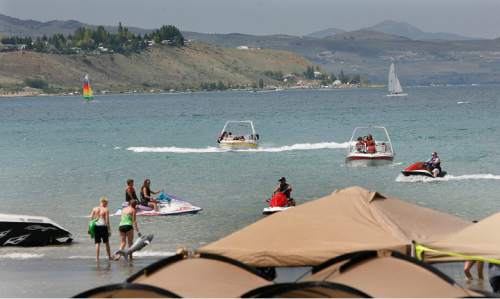This is an archived article that was published on sltrib.com in 2015, and information in the article may be outdated. It is provided only for personal research purposes and may not be reprinted.
Utah's finest beaches are found at Bear Lake, often called the Caribbean of the Rockies because of its inviting blue waters. And thanks to persistent low water, they are getting bigger as the lake level recedes, opening ever greater distances for recreational visitors to traverse to launch boats and set up picnics and beach chairs.
Now a move to allow driving on the exposed lakebed has ignited a contentious debate among lake users.
"That's like allowing people to drive through a playground," lakeside resort manager Steve Arnold told a Senate committee last week.
Two bills winding through the Legislature offer competing solutions to a dispute that pits many lakeside property owners and Garden City officials against public access proponents and upland owners.
Lakebed below an elevation of 5,923.65 feet above sea level is "sovereign" state lands, managed for all Utahns. But the water level fluctuates widely and is currently 10 feet below this high-water mark, meaning the shore is now hundreds of yards from parking lots.
The access issue flares whenever drought depresses the water level, but this time tension is exacerbated by quagga mussel, the exotic species that is invading Western waterways and wreaking ecological havoc.
State officials are desperate to keep the noxious mollusk out of the 112-square-mile lake straddling the Idaho border in Utah's Rich County. Utah legislation enacted two years ago with near unanimity imposed new restrictions, requiring everyone but lakeside owners to launch from state marinas and closing the lakebed to cars.
"We created private beaches," said Rep. Curt Webb, R-Logan, argued to allow driving along the shore. "I believe parallel travel is crucial to equality of access. It's a sad day when we get an opportunity and we lock our own people out."
Webb's HB140 and Sen. Jani Iwamoto's SB49 both would extend launching privileges to anyone one who gets quagga certification, but the bills diverge sharply on driving. So far, Webb's bill favoring motorized use has the upper hand, clearing both houses, while Iwamoto's more restrictive bill remains bottled up on the Senate floor.
HB140 still limits driving to the sole purpose of accessing a launch or a recreation site and no farther than a half mile from the 10 designated access points on Utah's 26-mile share of shoreline. It would lower the speed limit to 10 mph and ban camping on the lakebed.
Webb said he has no desire to see the shore used as "a racetrack," but motorized access is necessary to allow true public use.
"The only ability to fan out on the beach is done on foot," Webb said. "Most of us take many things to the beach — coolers, chairs. Without a vehicle to transport that, we have a limited-access policy for those who don't have lakefront property."
Elected officials from the lakeside town of Garden City disagree, arguing they have made extensive investments in pedestrian beach access that would be undermined if visitors drive out.
"Parallel travel will negatively impact the quality of life of homeowners on the beach, affect the ecology of the lake and is a big public safety issue," Mayor John Spuhler wrote to Iwamoto, a Salt Lake City Democrat. "The deep holes, ditches, sink holes, springs and historic canals will cause accidents for those who choose to break the speed limit."
Critics say Webb's plan would invite chaos and endanger children playing on the beach.
"This has been allowed before when there was less development around the lake and it was wisely terminated, as it proved hazardous," said Leslie Crandall, a Garden City homeowner. "This bill is not about access. It's about convenient-enough access. Safety is a priority that ought to trump convenience of beachgoers."
And the half-mile limit, which was reduced to 500 yards in a Senate amendment, is not enforceable and cars would contaminate the sand with oil, critics say.
"California or Hawaii would never allow that. Bear Lake is our ocean. Please protect it," said property owner Robert Gardiner of Holladay. "Is the Bear Lake we want bumper-to-bumper to cars? We don't mind people coming in. The solution is to get more access, not parallel travel."
Perhaps most significantly, HB140 would create what Webb calls "a paradigm shift" in the Department of Natural Resources management philosophy. Currently, lakebed is closed to motorized use unless posted otherwise. Webb wants to reverse that so lakebed is presumed open unless posted closed.
Such a move, however, would deprive State Lands officials of the ability to make decisions according to conditions on the ground, said Iwamoto while pleading with her colleagues in vain Thursday to postpone a decision on the controversial portions of Webb's bill.
Her SB49 would allow drivers to haul boats to the water and park on lakebed 100 feet or more from the shore.
"There is still public access to everyone. This does not limit the public at all to come to the beach," she said.
The two bills do have one point in common. Both would limit the launch permit requirement to just boats "propelled by machinery," thus exempting paddleboards, innertubes, kayaks and canoes from the anti-quagga measures.
Twitter: @brianmaffly



